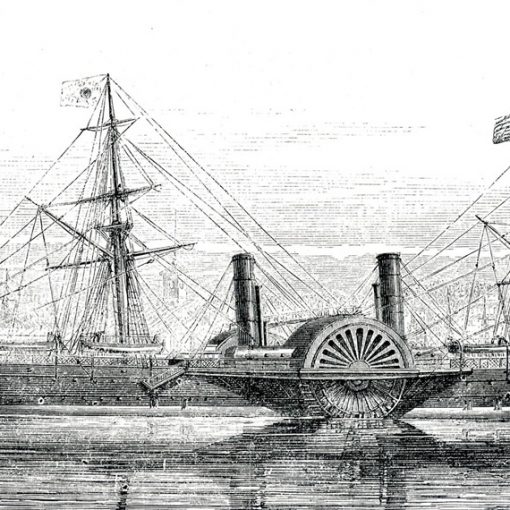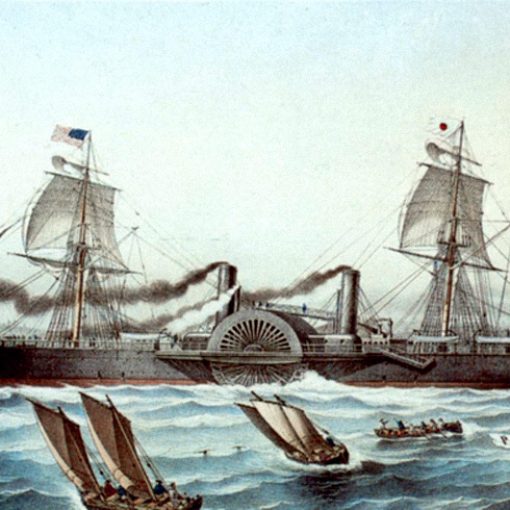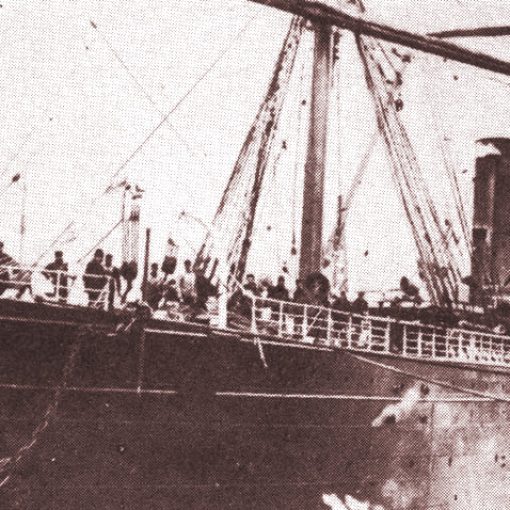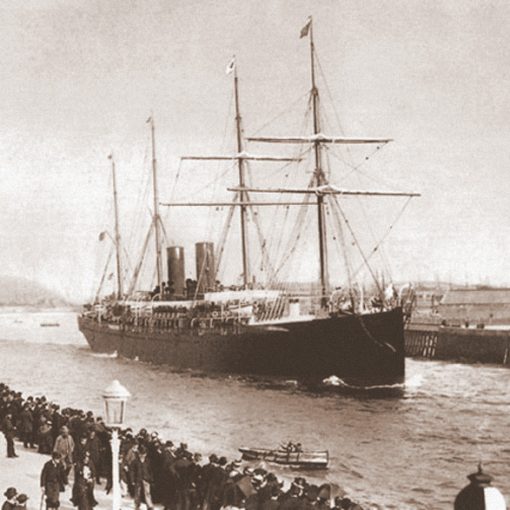1927 – 1959


Since the beginning of steam ship development in the early 19th century, the French had always been in the background concerning ship building. This was changed somewhat in 1912, when the country had their first prestige liner completed; the France. The 23,000-ton vessel opened up new ways in creating ocean liners, with her very ‘French’ style. This ship continued to be the French Line’s (or the Compagnie Générale Transatlantique) flag ship until the 1920s. The ship that would end the glorious days for the France was commissioned by the French Line in 1924. This ship was ordered along with three other ships, but they were not sisters. The first of these appeared in 1921, and she was the 35,000-tonner Paris. She was followed by the smaller De Grasse. These two vessels sailed together with the France, making the French Line a distinguished shipping company. The most interesting and passenger-attracting feature on board the French liners was their fabulous interiors. This would also set the pattern for the last of the quartet.
Ever since the war, no ship had been launched to match the pre-war giants. The British was satisfied with their German war prizes, and the Germans had to rebuild their country from scratch, and could therefore not afford to commission new liners. One nation was left to do this: France. So, after a popular trio, the French Line expanded into a quartet when they launched the new Île de France in 1926. The Île de France showed classical external lines and moderate speed, but was the first liner commissioned after the war to exceed 40,000 tons. Of course, the White Star Line’s 56,000-tonner Majestic entered service in 1922, but had been ordered in the early 1910s, and put on hold during the war. No, the interesting part about the Île de France was her gorgeous interiors.
The press had been snooping around the Chantiers de l’Atlantique Shipyard for months trying to find anything out about the new liner. Rumours came up, telling the public that this ship would be something extraordinary somehow. The rumours proved to be true.
After the Île de France’s sea trials on May 29, 1927, she was shown to the public and the press. Their reaction was extremely positive and enthusiastic. Never before had a ship shown its own style in interior design like the Île de France. In the past years, ships had imitated the shore-style. The Deutschland, the Olympic and the Imperator had all shown an interior that could be found on any castle or chateau situated upon the ground. The Île de France was a ‘Floating Hollywood’, a floating luxury resort in itself. The vessel had been launched after the famous ‘Paris Exposition des Arts Decoratifs et Industriels Modernes’ in 1925, and had obviously inspired the French Line. The term ‘Art Deco’ was born.
The Île de France’s maiden voyage started off from Le Havre on June 22. The warm welcome the ship had received in Europe continued when she reached America. Many Americans was tired of the old style and required something new. The Île de France arrived very appropriately, and the Americans seemed to love the new-style interiors of the ship they had nicknamed the Île.
The Île de France had been meant by the French to represent their country on the high seas, and that was not difficult to realise. The vessel included an entire Parisian pavement-café, a grand first class entrance hall and a dining room never dreamed of before, all very French – in Art Deco.
In the years before the war, ships had mainly been profitable because of the immigrants from Europe, but now the more distinguished group of people was aimed at. The Île de France had three classes, but the third class had not at all the leading position in passenger-statistics as on earlier pre-war liners. The first class staterooms were in many different styles, and the ship had the greatest number of de luxe suites on the seas. The third class was also something new. Steerage had almost disappeared from ocean travelling, and the staterooms were highly improved. People such as teachers and students, and budget-tourists were now found in third class. The other classes were for the rich and famed.
Even though the Île de France could not claim to be the fastest vessel in the world, she had the quickest mail-system between Europe and America. On board, she carried a small mail-plane that could take off 200 miles from shore, making the French liner the fastest in one aspect.
When the Depression arrived in 1929, many old ships went to the scrappers because they were not wanted by those who could still afford to cross the Atlantic. The Île de France was one of the favoured ships and did not suffer notably in the hard years. She continued to serve into the thirties with a steady group of passengers returning to her for her voyages. On one crossing in 1936, the Île de France encountered the brand new Queen Mary on the Atlantic. The French ship sent the following message to the Queen: ‘You are a very lovely lady’. The Queen Mary responded with: ‘And you will always be a queen’.
In 1939, another world-wide war broke out. The Second World War had started, and almost every ship was take over by their countries’ navy. The Île de France was laid up at Pier 88 in New York harbour, adjacent to the French Line’s new flag ship; the 80,000-tonner Normandie. However, the Île de France was not to be used by the French during the hostilities. She was turned over to the British as a troop-transporter in 1941 and made several runs for them until 1945, when she was decommissioned and handed back to the French Line in 1947.
After the war, the Île de France was once again the prime ship of the French Line, since the Normandie’s tragic end in New York harbour in 1942. The French Line immediately sent their ship to the Penhoët shipyard for conversion back to a passenger vessel. Many were the changes that occurred. Inside, the numbers of staterooms shifted to a lower number, in order to increase the still existing ones. The most apparent change was that of the exterior. The three funnels were removed and replaced by a more stylish duo. The straight black hull had been turned up to meet her upper fore peak, to resemblance with the French Lines new look as on the Normandie. These changes resulted in an increased gross tonnage, and now the French vessel could boast a 44,356-tonnage. The Île de France went back into service in 1949, and proved to be just as popular as before the war. She was still the ship for the rich and famed, and in 1950 she was given a sister; the Liberté. That ship had been the former German Blue Riband-holder Europa, so the French now operated a very distinguished group of ships, just as when the France of 1912 once had sailed.
The Île de France continued to sail the North Atlantic for the rest of the forties, very profitably. At about 11.00 p.m. on July 25, 1956, the Île de France was on one of her voyages from New York to Le Havre. At the same time the Swedish liner Stockholm collided with the Italian liner Andrea Doria. The French liner received a distress call from the stricken vessel, but hesitated somewhat before telling the Andrea Doria that she turned her bow and speeded towards the given position. When the Île de France arrived at the scene, she could hardly see anything. The French liner’s captain came up with the idea to lighten his entire ship to see better himself, and to help the Italian liner’s passengers. He could now see what was the matter; the Andrea Doria was listing heavily to starboard, and the Stockholm – who seemed to remain afloat – had a totally crushed bow. Since the Stockholm did not seem to be a very safe place to be, the latter ship’s lifeboats shipped the remaining Andrea Doria’s passengers to the Île de France. At 06.15 a.m., the French ship prepared to sail back to New York and land her new passengers. The Île de France made a wide circle around the Andrea Doria and blasted her whistle whilst hoisting the French flag thrice in order to honour the doomed liner.
By the end of the fifties, the passenger aeroplanes had taken many of the ocean liners’ passengers. In the turn between the fifties and the sixties, the jet planes were introduced, and the transatlantic liner service seemed to vanish at a rapid pace. The Île de France had become old, and there was no reason why she should not go to the scrappers. As always, the Japanese offered good prices, and on February 16, 1959, the Île de France, renamed Furansu Maru for this sole voyage, left Le Havre for her last time in order to meet her fate.
But fate would not come just yet, as it would show. During her period in Japanese hands, she was hired by an American Hollywood film team, who partially sank the ship, and used her in a disaster film called ‘The Last Voyage’ (very appropriate for the Île de France). After having finished the film, the Americans left and the Japanese scrappers raised the vessel and towed her to the scrap yard.
Even though the Île de France received this somewhat undignified end, she is remembered as one of the most beloved and trend-setting ocean liners in history. The Île de France left her mark as the first vessel with its own style; from then on, many buildings on land copied the design of the ocean liners.


Specifications
- 791 feet (241.6 m) long
- 91 feet (27.8 m) wide
- 43,153 gross tons
- Steam turbines powering four propellers
- 24 knot service speed
- Passenger capacity of 1,786 people (537 in first class, 603 in cabin class, and 646 in third class)













5 thoughts on “Île de France”
My father was drafted into the Army in 1943. He was married with three children and was 36 years old. He served in the 10th Infantry Division as a combat infantryman going all across France to the Rhine River in Germany. He just happened to be on the Ile de France from New York to Scottland as Bing Crosby’s U S O Troupe was. He survived the war and came home in August 1945. I don’t know what ship he was on then.
When I was eleven in 1956 Iwent to England from NY on the isle de France. after a month in England we were in Southhampton (England awaiting he arrival of thr Isle de France to return us to New York. We had to wait an extra day in Southampton because of the role the ship played in the of the passengers from the rescue Andre Doria. On the return voyage we were told of the role that the Isle de France had played in the rescue. Quite a tale for a young lad of Eleven. Still remember the great I had on the ship both ways even though our family went third class I went all over the ship from stem to stern, Great trip!
My father was repatriated on board the Ile de France from Halifax to Southampton in 1945 after a long journey from the Far East, having spent three and a half years in POW camps in Japan, so it’s ironic that the ship that took him on the last leg of his journey home ended her days in that country.
It’s amazing how different threads in life can come together in such unexpected ways. Thank you for sharing a bit of your father’s story with us!
I was just 4 years old when I sailed
On the Ile De France from Le Havre
To the US .It was Sept.
1937 during the German
Uprising.Boy was I lucky!